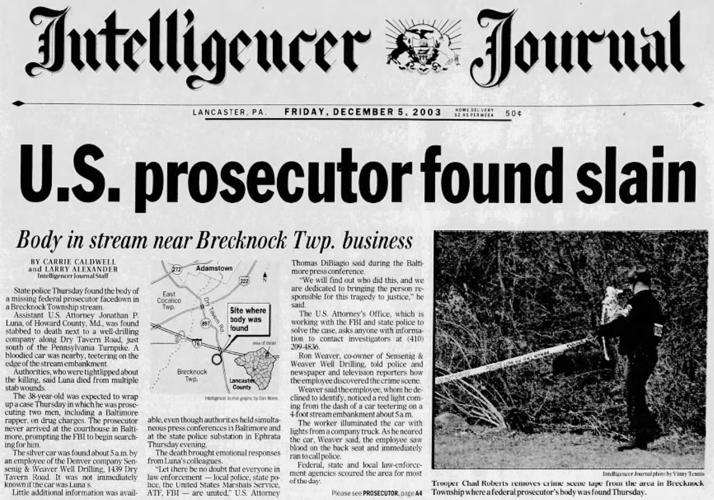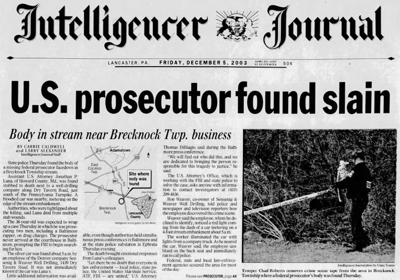Twenty years ago, the mysterious death of Jonathan Luna, 38, a federal prosecutor from Baltimore whose body was found face-down in a creek in Brecknock Township, quickly captured the interest of county residents - and the nation at large.
All three Lancaster newspapers ran the Luna story on their front pages for a whole week. Local reporters appeared regularly on cable news shows. And in the days before social media, amateur sleuths took to internet chat rooms to trade theories on the case.
Why did Luna's death resonate with so many people for so long? Perhaps because it seemed to provide a seemingly inexhaustible supply of twists and turns, new information and contradictions.
Two decades later, the case remains unsolved.
To mark the 20th anniversary of Luna's death, here's a look at how the case unfolded in real time in local newspapers, courtesy of the LNP | LancasterOnline digital archives.
The body is found
The first story about Luna's death appeared in the Intelligencer Journal on the morning of Friday, Dec. 5, 2003.
The day before, at about 5:30 a.m., an employee of Sensenig & Weaver Well Drilling spotted a silver 2003 Honda Accord idling on the bank of a creek near the business. Approaching the car, the employee saw that the interior was splattered with blood and called police.
Luna's body, riddled with stab wounds but still wearing a business suit and overcoat, was found in the creek below the car. The prosecutor, who was working on a case involving a Baltimore rapper accused of running a violent heroin ring out of his music studio, was reported missing by his wife on the morning of Dec. 4.
With a massive snowstorm bearing down on the county, state police, FBI agents and U.S. marshals mobilized at the scene to hunt for clues and gather evidence as quickly as possible.
Setting up banks of floodlights and enlisting the help of more than 100 cadets from the Pennsylvania State Police Academy, law enforcement officers worked through the night.
Over the course of the next day, the crime scene was buried under 10 inches of snow.
Gory details
On Dec. 6, the first details about the killing were revealed, as federal investigators and Lancaster County Coroner Dr. Barry Walp spoke to the media.
Walp said Luna, a married father of two, had suffered 36 stab wounds from a small knife. However, he was still alive when he was put into the creek - water was found in his lungs, which indicated his death was ultimately a result of drowning.

A state police trooper tapes off the site where Jonathan Luna's body was found in this photo from Dec. 4, 2003.
Most of the stab wounds were superficial, though a few were deep enough to cause internal hemorrhaging. Walp told the New York Daily News that he believed Luna had been "tortured" in the back seat of the car, given the amount of blood pooled there, and that his attacker may have been trying to extract information from him.
Law enforcement officers said that some of Luna's wounds were defensive, meaning he tried to fight back against his attacker. They also said they believed Luna's car had been left in neutral and an attempt was made to push it into the creek atop Luna's body.
Luna's death was the first homicide in Brecknock Township since the 1950s.
Why was he here?

Jonathan Luna
Over the next two days, the focus of the media coverage shifted away from crime scene details and zeroed in on the mystery of Luna's last hours.
Lancaster County District Attorney Donald Totaro would neither confirm nor deny an Associated Press report stating that investigators had determined that Luna's death was the result of a "personal dispute," rather than deadly fallout from his work as a federal prosecutor.
Luna's personal life contained its own mysteries, investigators learned: He had a secret credit card that his wife didn't know about. He may have posted on a website for people seeking sex. He seemed "distracted" at work. He was carrying more than $25,000 in credit card debt.
After receiving that late night phone call on Dec. 3, Luna went back to his office at 11 p.m., but then left again at 11:30, leaving his glasses and cell phone behind. He traveled through Delaware to the Philadelphia area, making ATM withdrawals along the way. His credit card was used on Dec. 4 at a King of Prussia mall.
The media spotlight
By Dec. 9, the Luna case had been featured on Fox News and CNN, and reporters from newspapers and TV stations in Baltimore and Washington were booked into Ephrata-area motels.
Some locals reacted with excitement; others with shrugs. Donna Ranck, owner's of Ranck's Family Restaurant in Bowmansville, said her regulars were "buzzing" about the killing.
"A man just left and said it was on Fox News," she said. "They're speculating - I think, we think, he thinks ... It's the big thing going on in this little town."
Meanwhile, Luna's father was intensely critical of the investigation, telling the Intelligencer Journal that he was unhappy with the slow pace and the lack of information shared with his grieving family.
The mystery deepens
As 2003 drew to a close, the Luna case continued to make regular - though no longer daily - appearances in the news. Still, no answers were forthcoming.
The county coroner said federal agents returned to spend another three hours examining Luna's body, while other investigators continued trying to unravel the mysteries around Luna's strange route on the night he was killed.
Initial thoughts that Luna may have been abducted and taken against his will to Lancaster County were called into question when a gas station attendant in King of Prussia said Luna bought gas for his own car and a second car at 3 a.m. on Dec. 4, less than three hours before his body was found, thus indicating that he may have met with his attacker willingly.
And a second person's blood was found in Luna's car, bolstering the theory that he fought with his killer.
Investigators also revealed that Luna had traveled to Pennsylvania several times recently, even telling his father that he was working on a case here. However, officials said he had no court business in Pennsylvania.
Why did Jonathan Luna take a roundabout route through three states to go from Baltimore to rural Lancaster County in the middle of the night? After nearly a month of intense detective work, investigators seemingly had no idea.
Unexpected twists
At the beginning of 2004, the Luna case dropped out of the media for several weeks. Then, on Feb. 14, newspapers reported two new revelations that renewed interest in the story.
First, investigators announced that, after another sweep of the crime scene area off Dry Tavern Road in Brecknock Township, they had discovered a penknife that they believed was used in the attack on Luna.
It was unclear why the knife was found two and a half months after the killing and was missed in the extensive searches during the case's early days.
Also, the New Era referenced a story from the Baltimore Sun that said federal agents were considering the possibility that Luna may have killed himself. They suggested that the shallow knife woulds, rather than signs of torture, were "hesitation wounds" which often occur in suicides by stabbing.
The suicide theory was roundly denounced by Walp, the county coroner who initially worked the case, and by Dr. Gary Kirchner, the new coroner who took office at the beginning of 2004.
A gap in the timeline; trouble at work

This map, published in March 2004, shows the route Jonathan Luna took on the night of his death, pieced together from EZ-Pass, credit card and ATM records.
On March 13, 2004, investigators announced that they were seeking the public's help in the Luna case. A $100,000 reward was offered, and police said they were focusing particularly on a gap in the timeline they put together based on Luna's EZ-Pass, ATM and credit card data.
During that window, they speculated, Luna might have had car trouble and been helped by someone who turned out to be his killer.
A few months later, new information came to light about Luna's work - a former colleague asserted that Luna was on the verge of being fired, and had retained legal counsel for job-related issues.
The story fades away - mostly
As 2004 drew to a close, the Luna case had largely faded from the public eye. Investigative work was still going on, but quietly, and new information was scarce.
The one-year anniversary passed, with the FBI admitting it had found no evidence that Luna met with anyone on the night of his death.
Then the two-year anniversary came, marked by a vigil held by friends and family at the site where his body was found.
On Dec. 20, 2005, a new revelation came to light: Luna had been facing a lie-detector test in connection with $36,000 in missing evidence from a case he had worked. This information fueled speculation that Luna committed suicide and was not murdered, as Lancaster County authorities still believed.
By the beginning of 2006, anonymous federal sources were saying that Luna committed suicide, and the FBI asked Kirchner, the county coroner, to change the official manner of death to suicide. Kirchner refused, standing by his ruling of homicide.
The Jan. 15 Sunday News article that revealed that detail also contained a list of nine unanswered questions about the case. By that time, too, some of the earlier assertions about the case - including the idea that he paid for two tanks of gas in King of Prussia and that there were two blood types in the car - didn't pan out.
Harrisburg author William Kiesling, who wrote a book on the Luna case, said he suspected that Luna was killed in relation to a case he was working on, and the anonymous pieces of information revealed by federal investigators were part of a cover-up.
Private investigator Ed Martino took things a step further, and suggested Luna may have even been killed by a corrupt federal agent.
Local officials were unanimous in their rejection of the FBI theory of suicide. Kirchner even offered to convene a coroner's inquest, where FBI agents could offer evidence and testimony to support their suicide theory.
The FBI never responded.
Over the next 15 years, the Luna case languished - officials repeatedly confirmed that the case was still open and active, but the only new information revealed in local newspapers was coming from sources outside the investigation.
(For example, in December 2006, Kiesling, the author, shared new information from the mortician who prepared Luna's body for the funeral stating that Luna's injuries included knife wounds to his back and "ragged" wounds to his genitals.)
There were several battles over records and information in the case - in 2007, an inquest was again requested and denied; the next year, Martino, the private investigator, battled with new coroner Dr. Steve Diamantoni over release of the autopsy report in the case.
And most recently, in 2020, LNP Media Group went to court in an effort to compel the district attorney's office to release coroner's office records related to the case that had been missing for 16 years.
In 2021, Judge David Ashworth ruled the records would remain sealed - meaning the curious case of Jonathan Luna would remain a mystery.





 JED REINERT | Digital Staff
JED REINERT | Digital Staff


